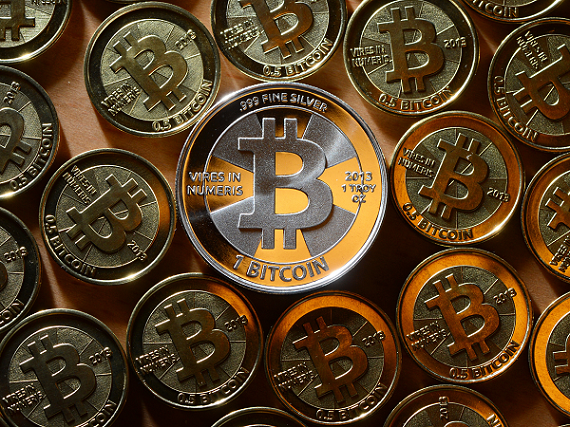The author of this article is Mr. Sunil Aggarwal. Editor-in-Chief of Theory Frames, an online learning solutions start-up. He taught Political Science and International Relations for fourteen years and also stayed at IIAS, Shimla as IUC Associate Fellow for two terms. He is an independent researcher who works in the area of “Politics of Money”.
Recently at FIBAC 2015, Mr. R. Gandhi, RBI Deputy Governor delivered a speech, “Disruptive Innovation and Inclusive Growth – Some Random Thoughts” and two prominent themes in that speech were crypto-currency and crowd-funding. He expressed great possibilities hidden in these unique innovations of 21st century. To him, a “Crypto currency is a digital currency in which encryption techniques are used to regulate the generation of units of currency and verify the transfer of funds, operating independently of a central bank” and crowd-funding is “the practice of funding a project or venture by raising monetary contributions from a large number of people, typically via the internet.….it is a form of alternative finance, which has emerged outside of the traditional financial system.” Still, he does not find them desirable because they “both hope to operate in a regulator free environment. In matters financial… unregulated financial system has immense scope for depriving ordinary public of their hard earned money and therefore highly risky to be permitted to grow.…. Secondly, both have the potential to support criminal, anti-social activities like money laundering, terrorist funding and tax evasion.”
Such a speech by a senior RBI functionary seems quite a conventional way of saying both good and yet bad things about a paradigm shift in the world of money and finance. This change is so big that every big financial institution is working on it. British banks are seriously exploring it. London is not just the financial centre of the world but also the new Fintech capital of the world too. Federal Reserve is working on the new framework of real-time payments where members of Ripple team, the crypto-currency giant are also involved. Australian Banks are testing it. IBM, MIT, Santanders and many more are building advanced models of blockchain for use in financial industry. Against such a backdrop, the ideas of RBI deputy governor show less than adequate understanding of institutional changes that RBI may need to accommodate for the crypto-currency world in future. It seems that a lot of hard work is yet to be done on this front by the regulator. A better way of what could have been possible in this regard is to re- imagine the speech the deputy governor might have made.
1. The kind of traction that bitcoin has gained in less than six years is quite a challenging proposition for central banks. To be more precise, this is the challenge from the open source and decentralized nature of money and finance to the centralized regulators of the present world. The world is watching a bottom-up model instead of a top-down model that we have got almost used to. There would be nearly five billion smartphone users in the world in another five years. In a cashless society, the physical hold of a paper currency will need to be replaced by a mobile interface and technology back-end. It is a change that is totally new and disruptive for all of us. It may be a moment of creative destruction but if we remain unmindful, this destruction may not be creative too. It seems to be issuing a wake-up call to all the regulatory authorities as the nature of challenge is much deeper than is visible at present.
2. Bitcoin is the first-ever authentic digital version of a bearer asset. All physical currency notes are also bearer assets of multiple denominations. The natural leadership of a central bank emerges from the fungible nature of this bearer asset. It is the simplest and the safest mode of exchange. Central bank performs its seigneiorage functions with absolute quality and public safety. This public acceptance of RBI in its monetary grammar is a great asset. The challenge is to reproduce this kind of authenticity in the digital domain too. Bitcoin does have the first mover advantage but it is far away from the scale of fiat currencies. The time available should be used to reproduce the digital rupee payment network the way it operates on cash front. Payment banks are one way to take in this direction but to match equivalence of ease, efficiency and security of bitcoin, we need to go a bit further. The best way forward is to erase the friction of payment during transaction and conversion of rupee. We need to develop a core technology group on the lines of something like Ripple, Ethereum or Stellar like crypto-currencies. They provide sufficient variety of management alternatives that a central bank can replicate. With the help of institutions like NIPFP, C-DAC and NIC, RBI can develop in-house technology solutions based on blockchain.
3. Banking on tap for Indian market is already being given a serious push in the form of payment banks and small banks but banking needs to change not in terms of aiding financial inclusion but also in terms of reducing costs through seamless unity of payment platforms. The blockchain technology is the biggest gift of bitcoin. As all banks have similar systems for deposit management, payment systems, databases, credit and debit ledgers, credit card, lending and so on, this creates needless duplication of identical functions across banks and hence unnecessary costs for the banking industry. Blockchain can reduce it by creating industry-level systems of record in such a way that everyone can use them. What may be needed is some sort of “consortium blockchain” which in words of Vitalik Buterin is “a blockchain where the consensus process is controlled by a pre-selected set of nodes; for example, one might imagine a consortium of 15 financial institutions…… The right to read the blockchain may be public, or restricted to the participants, and there are also hybrid routes …… with an API that allows members of the public to make a limited number of queries and get back cryptographic proofs of some parts of the blockchain state.”
4. India has a unique and single register of identities/e-KYC in form of Aadhar. With its support, we can design a model of crowd funding. What is needed is that RBI must innovate on this turf by issuing an open-source software model of crowd-funding. The challenge is that this model has to be technology-centric as well as financially safe. This may be called LINUX of crowd-funding models. Micro-investments for crowd-funding can be modeled on the micro-payments and share issuance can be transparently seen on the blockchain. SEBI can join for this financial innovation. Small-cap companies or start- ups can be allowed to participate in this model. Instead of fighting against crowd-funding, we need to develop our own methods of easy and reliable fund generation. If this kind of public software can be made popular as well as mandatory for crowd-funding in India, this would also be paradigm shift in the role of central banks. From a money issuer to a technology-issuer, this would be a great achievement.
5. The fast rise of crypto-currencies beyond 600 in less than two years is not a happy trend and it is expected to cross 1000 in another couple of years. If even 90% of these currencies die, there would be around 100 such currencies still left and that would be still a great number to tackle. They are already emerging as the favourite medium for hawala transactions as well as banned goods and drugs online. Despite closure of Silk Route, an online market-place for sale of illegal goods with bitcoin, there have emerged dozens of new ones. Tor network and proxy nature of servers make it too difficult to stop them. Defense may not be right strategy for central banks as far as crypto-currencies are concerned. It seems that time has come for all central banks to come together and start working on this challenge. More is the friction between currencies; more is the incentive to shift to alternative crypto-currencies. A user cannot make instant micro-payment across currencies with enough ease and at low cost. This can be corrected by ending the fragmented nature of our monetary systems. We need to remove the multiplicity of standards and protocols and reduce the compliance cost too. The need for cooperation and collaboration is so high that inter-currency payment friction should be eliminated with only one goal of real time payments. The entire world should move towards this goal and there should be no lapse in it. If fiat currencies can do what crypto-currencies are doing, with a much better record of public acceptance, scale and efficiency, the world may not need so many of crypt-currencies.
Click on the bitcoin logo below to buy, use or accept bitcoin. Unocoin is India’s most popular bitcoin wallet.
To read the bitcoin white paper, visit: https://bitcoin.org/bitcoin.pdf








